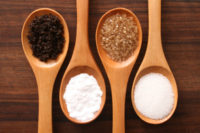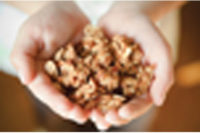Researchers: Sugar Decomposes, Not Melts

"This discovery is important to food scientists and candy lovers because it will give them yummier caramel flavors and more tantalizing textures. It even gives the pharmaceutical industry a way to improve excipients, the proverbial spoonful of sugar that helps your medicine go down," says Shelly Schmidt, the university professor for food chemistry.
"Certain flavor compounds give you a nice caramel flavor, whereas others give you a burnt or bitter taste. Food scientists will now be able to make more of the desirable flavors because they won't have to heat to a 'melting' temperature but can instead hold sugar over a low temperature for a longer period of time," she says.
In a presentation to the Institute of Food Technologists about the importance of the new discovery, Schmidt told the food scientists they could use the new findings to manipulate sugars and improve their products' flavor and consistency.
Candy-makers will be able to use a predictable time-temperature relationship, as the dairy industry does in milk pasteurization, to achieve better results, she says.
Schmidt and graduate student Joo Won Lee did not intend to turn an established rule of food science on its head. However, they began to suspect that something was amiss when they could not get a constant melting point for sucrose in the work that they were doing.
"In the literature, the melting point for sucrose varies widely, but scientists have always blamed these differences on impurities and instrumentation differences. However, there are certain things you'd expect to see if those factors were causing the variations, and we weren't seeing them," Schmidt says.
The scientists determined that the melting point of sugar was heating-rate dependent.
"We saw different results depending on how quickly we heated the sucrose. That led us to believe that molecules were beginning to break down as part of a kinetic process," she says.
Schmidt says a true or thermodynamic melting material, which melts at a consistent, repeatable temperature, retains its chemical identity when transitioning from the solid to the liquid state. She and Lee used high-performance liquid chromatography to see if sucrose was sucrose both before and after "melting." It wasn't.
"As soon as we detected melting, decomposition components of sucrose started showing up," she says.
To distinguish "melting" caused by decomposition from thermodynamic melting, the researchers have coined a new name --"apparent melting." Schmidt and her colleagues have shown that glucose and fructose are also apparent melting materials.
Another of Schmidt's doctoral students is investigating which other food and pharmaceutical materials are apparent melters. She says the list is growing every day.
From the July 28, 2011,Prepared Foods' Daily News.
Looking for a reprint of this article?
From high-res PDFs to custom plaques, order your copy today!







